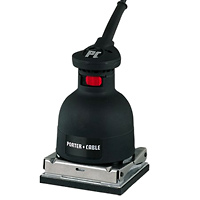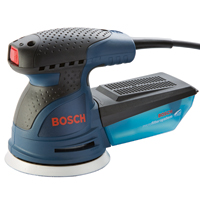Two of the most commonly used power sanders for woodworking purposes are the sheet sander and the random orbital sander. While either of these tools can be used for many of the same basic sanding tasks, there are some fundamental design differences between them and situations where one is more appropriate than the other. If you’re in the market for a sander and not sure if you should buy a sheet sander, a random orbital sander, or perhaps both, then read on…
Sheet Sander

Sheet sander
The sheet sander, aka palm sander, sheet palm sander, or pad sander, has been around much longer than the random orbital sander and has steadily improved over the years. It operates by vibrating a rectangular sanding pad in a back-and-forth circular motion at high speed. Because it lacks the random pattern of a random orbital sander, the sheet sander can leave swirl marks, especially when moving at an angle against the grain. For this reason, it is important to keep the sander moving – with the grain as much as possible – and to use progressively finer grits of sandpaper.
A nice feature of sheet sanders is that they use ordinary sheets of sandpaper, which cost considerably less and are more readily available than the precut sanding disks used by random orbital sander. At one time, sheet sanders used half-sheets of sandpaper but modern models mostly use quarter-sheets.
Modern sheet sanders are generally comfortable to hold, as the top is molded to conform to the palm (hence the term “palm” sander). Even so, the vibrating action tends to cause hand numbness so try to take breaks when sanding a large project. If your hands feel like they’re vibrating after you turn off the machine, that’s a sign you’ve been sanding too long.
If there is lots of material to remove, a random orbital sander is a better option than a sheet sander because it sands more aggressively, ultimately saving you time and hand fatigue. On the other hand, if you’re making a final pass on wood or sanding between coats of paint or finish, a sheet sander is a good choice. I also like to use a sheet sander when I’m sanding the narrow side of a board or rounding an edge because I find it easier to control the tool. With a random orbital sander, it’s easier for it to get away from you if you’re not careful. Another advantage of sheet sanders is that they can sand into corners because they have a rectangular base.
Random orbital sander

Random orbital sander
The random orbital sander has come on strong in recent years and for good reason. Compared to a sheet sander, this newer breed of sander produces fewer swirl marks, sands faster, and causes less hand numbness. It is truly a boon to sanders worldwide. In fact, the venerable Norm Abram says that he uses random orbit sanders more than any other type of sanding tool in the New Yankee Workshop.
The magic behind a random orbital sander is an offset drive bearing that moves a circular sanding pad in an elliptical manner so the same path is not followed twice. Think of it as a dual motion: the pad spins while also moving in an orbital pattern, greatly minimizing the tiny swirl marks that a sheet sander or other non-random may leave behind. This is especially advantageous when sanding joints where boards with grain running in different directions come together. However, if the joint is a corner with projecting sides, the circular pad of the random orbital sander won’t fit into the corner. In this case, the humble sheet sander may have to come to the rescue.
The random orbital sander is a wonder tool but it does have some drawbacks (fairly minor I think). As just mentioned, one of these is an inability to get into corners. Another is that the sanding disks are not readily available in just any old hardware store, and they are more expensive than common sandpaper sheets. The aggressiveness of a random orbital sander can also be a disadvantage at times. For example, you can gouge the wood surface if you bring the sander up to speed before lowering it to the wood. And for sanding finishes or edges, the random orbital sander can be a bit difficult to control.
I’ve read articles that say it is not necessary to change grits when sanding with a random orbital sander because of the reduced tendency to leave swirl marks. While the tool may be a bit more forgiving than a sheet sander, I recommend going through the normal grit sequence. This will produce the smoothest surface fastest.
Random orbital sanders use either adhesive backed or hook-and-loop (think Velcro) disks. Many woodworkers seem to prefer the hook-and-loop models because the disks can be quickly changed during a sanding job and reused until the abrasive wears out. In contrast, the adhesive-backed disks can’t be reused and residual adhesive occasionally has to be removed from the sanding pad. However, the adhesive-backed disks are cheaper than their Velcro-like cousins (sometimes half as much) so factor that into the equation when deciding which type of sander to buy.
Pros and Cons
For quick reference, here is a summary of the pros and cons of the sheet sander and random orbital sander.
Sheet Sander
- Better at getting into corners.
- Must keep moving and follow the grain to avoid swirl marks.
- Less expensive than a random orbital sander.
- Less expensive to operate because it uses standard sandpaper.
- Works well for sanding between finish coats.
- Removes material less quickly.
- Paper tends to tear once it wears or if an edge is caught.
- Extended use can results in hand numbness.
Random Orbital Sander
- Sands in random pattern resulting in fewer swirl marks.
- Can sand joints with grain of each board going in different directions.
- Faster than a palm sander at removing material.
- Less hand fatigue than a vibrating sheet sander.
- Easy and quick to change sanding disks.
- Sanding disks not as commonly available as sandpaper sheets.
- Not the best choice for sanding corners,, edges, or finish coats.
- Can gouge the surface if not careful when starting sanding.
The Bottom Line
If you had to purchase just one sander, a random orbital sander is probably the way to go. It’s versatile, it does a great job, and can do most anything a sheet sander can do. However, most serious woodworkers will likely want to have both tools in their sanding arsenal given the relative merits of each machine. I personally use both a Porter Cable sheet sander and random orbital sander in my shop and really appreciate having both around (especially when a buddy is around to help out with a big sanding job). Regardless of what specific brand you buy, make sure the sander feels comfortable in your hand and comes with a locking switch and dust collection (which most decent ones do).


Wonderful post. I’m a new and part time woodworker for restoring my house. I have to need orbital sander but didn’t choose the correct one. Actually, want to know which is the best orbital sander brand between Makita or Bosch?